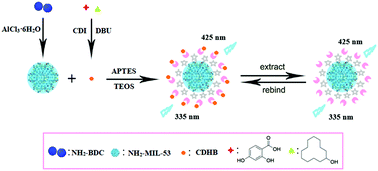Novel molecularly imprinted polymers on metal–organic frameworks as sensors for the highly selective detection of zearalenone in wheat†
Abstract
The work describes an opto-sensor for the highly sensitive detection of the zearalenone (ZON) in wheat. A molecularly imprinted polymer layer was coated onto the surface of a luminescent metal–organic framework with cyclodo-decanyl-2,4-dihydroxybenzoate (CDHB), an analog of ZON, chosen as the template and 3-aminopropyltriethoxysilane (APTES) as the functional monomer. The obtained MOF@MIP (MMIP) was fully characterized by scanning electron microscopy (SEM), transmission electron microscopy (TEM), X-ray diffraction (XRD), N2 adsorption–desorption measurements, and Fourier transform infrared spectroscopy (FT-IR). Under optimal conditions, the relative fluorescence intensity of MMIP decreased linearly with a concentration of ZON ranging from 0.05–1.0 mg L−1, with a detection limit of 0.018 mg L−1 and a good recovery of 95.53–98.01% (RSD < 4.7%). The sensor was stable and selective. Ultimately, the rapid and accurate detection of zearalenone in wheat was successfully realized.



 Please wait while we load your content...
Please wait while we load your content...